55
56-57
THE GERMANS, forced to abandon the Volturno Line, their first natural defensive position, were now compelled to withdraw their main strength hastily twenty miles northward to the Mount Massico ridge and the high ground north and west of Teano and Presenzano, where they established their "Barbara Line" (Map No. 30, inside back cover). While smaller forces stayed behind to carry out delaying tactics, their major elements took up positions along the mountain barrier for another coordinated stand. Once more the enemy would have the advantage of terrain, for here the steep hills and narrow defiles would severely limit the speed and strength of an Allied assault. Meanwhile, the task of the British and Americans was to overcome enemy rearguard actions and to engage the main German forces before they could organize another strong defense.
North of the Volturno, the Fifth Army was still some twenty-five miles from the objective assigned by the 15th Army Group, the Sessa Aurunca-Venafro-Isernia area, where the army's right flank was to make contact with the Eighth Army. In preparation for the advance, General Clark, on 14 October, had altered the corps boundaries, giving 10 Corps the ridges northwest of Triflisco. The new boundary line widened 10 Corps' area by about three miles and gave the 56 Division a chance to move east where a bridgehead was already established. Prevented from crossing at Capua, the division might now use the bridge which had been built by VI Corps at the Triflisco Gap and might outflank the Germans still holding sections of their river line west of Capua. By advancing across the ridges to the Calvi Risorta
55
56-57
Hills, 56 Division would control one end of Highway 6, a paved road running from Capua to Rome. The rest of 10 Corps was to drive north some seven miles over the coastal plain toward the Mount Massico, hill mass at the western end of the mountain line.
North of the Volturno-Calore junction the Matese Mountains, blocking off any movement to the east, narrowed the zone in which VI Corps was to operate (Map No. 17, page 56). General Lucas issued orders for the divisions to shift their routes of advance: the 3d Division, on the extreme left, would take over the mission of the 34th, which had held the center; the 34th, in turn, would move to the right to make contact with the 45th, which was then to be relieved. The corps, advancing on both sides of the river, was then to drive northward to the mountains around Venafro and Isernia. By capturing the key hill positions along their route, the divisions of VI Corps would gain control of the upper Volturno Valley, two to five miles wide.
The 3d Division, which was originally to have gone over the Triflisco ridges to force the final withdrawal of the enemy from the river, was now free to concentrate on pursuit. From its position on the southern slopes of the Mount Maggiore range, the division was to skirt the highest peaks by turning northeast to Dragoni and there prepare for an advance to the mountains around Baia e Latina, Roccaromana, and Pietramelara, at the northern end of the Maggiore hill mass.
On 14 October the 34th Division was across the river but not yet ready to move. In its sector the engineers, hampered by observed artillery fire, had been unable to construct either of the bridges which had been planned for the division's supply. Water, rations, and ammunition had to be brought across the river by hand or in assault boats and then transported by carrying parties over six miles of rugged terrain. Nevertheless, preparations were made to carry out the new orders. The 34th was to move up the valley beyond Alvignano and then cross to the 45th Division sector on the east side of the river, where the enemy had already been pushed from the heights dominating the Volturno-Calore valley as far north as Faicchio. Until the 34th came into this area, the 45th Division was to continue clearing the valley between the upper Volturno and the Matese Mountains. At Piedimonte d'Alife the 45th, which had landed on D plus 1 at Salerno and fought through the entire Italian campaign, was to go into corps reserve.
58
During the next four weeks the men had to fight their way into the forward limits of a great system of mountain defenses. The terrain through which the 3d and 34th Divisions were ordered to move is a series of high, rocky, brush-covered ridges, interspersed with deep ravines, narrow farm valleys, and small broken tablelands. The only road across the mountains west of the river branches off from Highway 87 northeast of Triflisco and winds past small, scattered villages until it descends at Dragoni to the valley of the upper Volturno. Another road, from Caiazzo to Dragoni, runs along the valley itself, just east of the Maggiore range. Continuing from Dragoni, this road crosses the river and leads northward along the base of the Matese range. These precipitous mountains, sealing off the area on the east, restricted the American advance to a course along their foothills.
The natural difficulties of terrain were heightened by the changeable late autumn weather and the enemy's determination to prevent our troops from moving swiftly northward. Fog, rain, and mud hampered the bringing up of supplies and added to the weariness of the men. In his rear areas the enemy built bunkers and emplaced weapons, skillfully camouflaging these positions by blending them with the stone walls which criss-cross the slopes and valleys. Meanwhile, other German units mined and demolished roads and bridges and ambushed the many circuitous mountain trails along which our units would have to pass.
The 3d Division Drives Toward Dragoni
The 7th Infantry was in the hills southeast of Pontelatone on the afternoon of 14 October, when it was ordered to change its course and drive up the road through Liberi to Dragoni along which the enemy was reported to be withdrawing (Map No. 18, page 61). At 1645 the 3d Battalion, supported by tanks and tank destroyers, led the attempt to take Liberi before dark, but at 2250 the report came in that heavy resistance was holding up the battalion's advance on the southwest side of Mount Fallano. Artillery fire was falling on the road south of Cisterna, a little stone village on the forward slopes of the mountain. While one platoon of the battalion attempted to go through the town in the face of small-arms and machine-gun fire, Company I circled around to outflank the enemy from the northwest, following a road which winds above the valley between Mount Nizzola and Mount
59
AN AMERICAN PATROL FOLLOWS A STONE-PAVED TRAIL on the outskirts of a village. In a typical delaying action the enemy attempted to halt the advance at a rifle platoon by posting two light machine guns on either side of a trail such as this and stationing men farther in the rear to lob grenades at our troops. According to the platoon leader, the Germans had a perfect ambush.
Fallano. Company K was to move forward on the right, along a mountain trail at the edge of the ravine dividing Mount Fallano from Mount Majulo to the south. The effort to flank Cisterna was unsuccessful, for in the darkness the men became scattered on the steep, brush-covered ground. The enemy continued to defend the village. Three tanks came up to fire on enemy machine-gun positions, but the first was hit by a mortar shell which knocked a track off. Infantrymen who tried to repair the damage met heavy fire, and the tank had to be abandoned. At midnight the 2d Battalion was committed to bypass Cisterna on the left and reach the high ground above Prea, the next village in the regiment's line of advance. Climbing over the stone terraces in the valley northwest of Mount Fallano, the men made their way to the broken tablelands north of Cisterna. Here they were delayed by enemy tanks, used as roving artillery, but by daylight the 2d Battalion was above Prea, on the slopes of Mount Friento, and overlooking the road to Liberi.
60
At 0830 on 15 October, the 1st Battalion prepared also to bypass the 3d Battalion at Cisterna. Moving up the ravine southeast of Mount Fallano, the battalion went through Strangolagalli and reached the broken country on the right of the Cisterna-Liberi road without drawing any fire. Later, on the ridges west of Sasso, the men were opposed by small arms and mortars, but during the afternoon they gained a footing on Hill 561. At 1500 Cisterna was reported captured, and the 3d Battalion was ordered to reorganize and remain in reserve, ready to assist either of the advance units. Meanwhile, the 2d Battalion made steady progress around the slopes of Mount Friento. Shortly after midnight, having overrun an enemy 6-inch gun and a 20-mm antiaircraft gun, the battalion hit a machine-gun protective line west of Villa and suffered heavy casualties. To assist the 1st Battalion, which was still fighting south of Liberi, the 3d Battalion was sent up at 0330 on the 16th.
All three battalions of the 7th Infantry were in the vicinity of Villa and Liberi by the morning of 16 October and were engaged in sharp
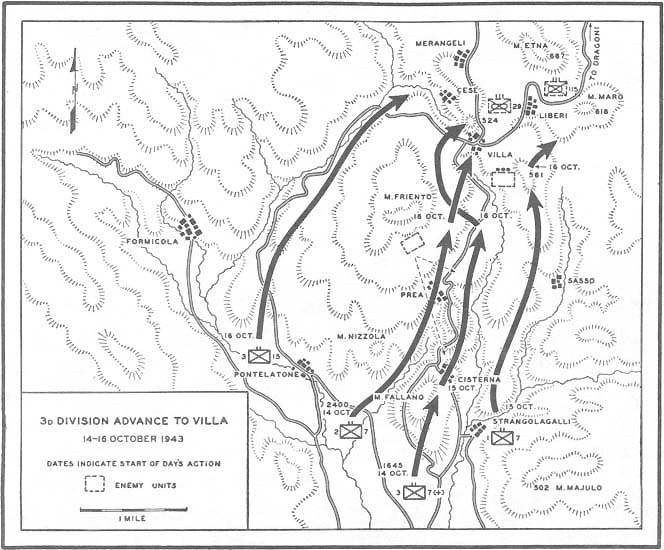
61
CISTERNA, LIBERI, AND MAJORANO were centers of resistance where the enemy, with small forces, usually of platoon, occasionally of company size, delayed the advance of the 3d Division. At these towns the delaying units could easily maintain communication and from them they could withdraw quickly.
fighting with elements of the 29th and 115th Panzer Grenadier Regiments. The 3d Battalion, which had gone along the road south of Villa behind the 2d Battalion, was twice repulsed by artillery and mortar fire in its efforts to storm Hill 524, a knob less than fifty meters above the tableland between Villa and Liberi. Preceded by an intense artillery and mortar barrage, an enemy platoon counterattacked on Hill 561 but was beaten off by the 1st Battalion. In the afternoon the Cannon Company was sent up the road past Prea to support the drive on Liberi. The 3d Battalion, 15th Infantry, was at
62
this time attached to the 7th Infantry, with instructions from General Truscott that it be used to attack the high ground north of Villa before daylight of the 17th. Before dark the battalion was west of Villa, having come from Pontelatone. The 7th Infantry's attack was set for early the next morning. During the night the Germans made no more counterattacks against these units and seemed to be preparing to pull out of Liberi.
At 0615 the next morning the attack was renewed (Map No. 19, page 64). The enemy had withdrawn beyond Liberi and the 2d Battalion met no resistance when it entered the village at 1000. Pushing on to the right and left, the assault battalions occupied Mount Etna and Mount Maro. The leading elements of the 1st Battalion then made their way down into the narrow farm valley beyond which the Liberi-Dragoni road winds around the base of Mount Etna to the town of Majorano di Monti. As the battalion approached the village at 1145, however, it was pinned down by rifle, machine-gun, and artillery fire from both sides and was held south of Majorano di Monti until dark. The 2d Battalion followed by the 3d climbed the hills behind Liberi to bypass the 1st and took the road through a high pass between Mount Etna and Mount Maro. Throughout the after-
THE TOWN OF VILLA and the surrounding hills were held by enemy troops instructed to man their positions indefinitely. On the evening of 16 October American artillery fired it concentration against tanks in Villa and personnel on the flats to the north. That night the enemy threatened also by the 3d and 34th Divisions' advance, abandoned the town.
63
noon the 2d Battalion fought along the forward slopes of Mount Etna in an effort to envelop Majorano di Monti. On the right the 3d Battalion, instructed to reach Dragoni by the morning of 18 October, made fair progress.
While the 7th Infantry drove toward Liberi, the 15th advanced on the left. On 16 October there had been continuous fighting along the ridges west and southwest of Pontelatone, but during the night the regiment had moved steadily forward. By noon of the 17th, the 15th Infantry was around Villa, preparing to push north across the mountains to seize the high ground east of Pietramelara, a town on the lateral road connecting Highway 6 with the upper Volturno Valley. This move over rocky slopes, across deep valleys, and through wooded ravines was made to protect the left flank of the division.
At midnight the 1st Battalion, 15th Infantry, reached the slopes of Hill 446. At the base of the hill, along a deep stream, lay the village of Roccaromana, which was held by the enemy. The 2d Battalion occupied Hill 330 to the southeast and sent patrols to block the road between Statigliano and Latina. The 1st Battalion moved over Hill
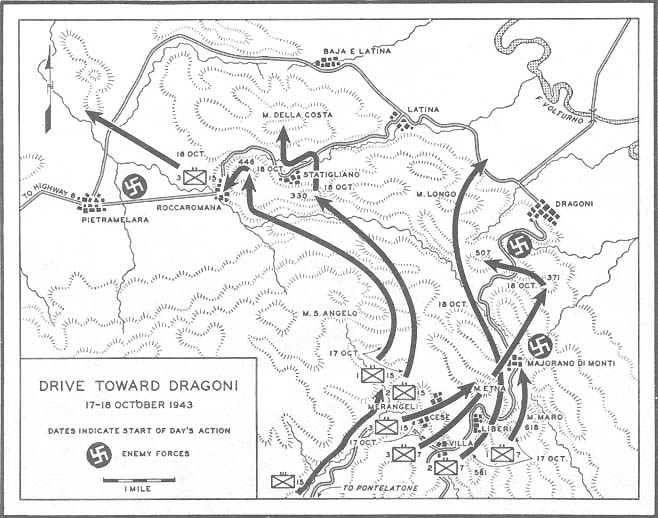
64
446 on the morning of 18 October and attacked Roccaromana. Pockets of enemy resistance on the hillside and out in the valley caused considerable difficulty, but the battalion reported at 1520 that it had the village. The 2d Battalion occupied the slopes on Hill 446 where the 1st Battalion had been and at night drove on to seize Mount della Costa, to the north. The 3d Battalion, with Company L in the lead, then advanced between the two battalions to cut the road between Baja e Latina and Pietramelara.
The mission of the 3d Division, to capture Liberi, advance to the highway along the Volturno, and seize the bridges northeast of Dragoni, had not yet been accomplished. The 3d Battalion, 7th Infantry, had been ordered at 1600 on 17 October to go up the road through Villa toward Dragoni with instructions that General Truscott expected it to be in Dragoni by daylight. The men moved rapidly up the winding road, bypassing the 1st Battalion at Majorano di Monti reached Hill 371 south of Dragoni soon after midnight, and sent patrols to the left toward the town. After daylight on the 18th, the battalion crossed the road to Hill 507. Meanwhile, the 2d Battalion had occupied Mount Longo west of Dragoni, and forward elements made their way down the hill to cut the road toward Baja e Latina. General Truscott then directed Col. Sherman to stop the advance and rest his men, saying: "You have done a damn good job with those battalions and I don't want them to go any farther. . . . They are within reach of that road, and if they can put up their mortars where they can interdict it, then that will be all I want from them."
The 34th Division Advances Along the River
The immediate task of the 34th Division after it took Caiazzo was to
drive the enemy up the valley beyond Dragoni
(Map No. 20, page 66). The 2d Battalion,
135th Infantry, moved up to the low ridge south of Ruviano on the night
of 14 October and prepared to take the village. Shortly after midnight
General Ryder, still unable to get sufficient supplies and artillery across
the Volturno, postponed plans for the attack on Ruviano. Meanwhile, General
Clark had received information that the enemy was withdrawing before VI
Corps and ordered all divisions to continue on their missions without delay.
General Ryder then directed the 135th Infantry to resume its advance,
65
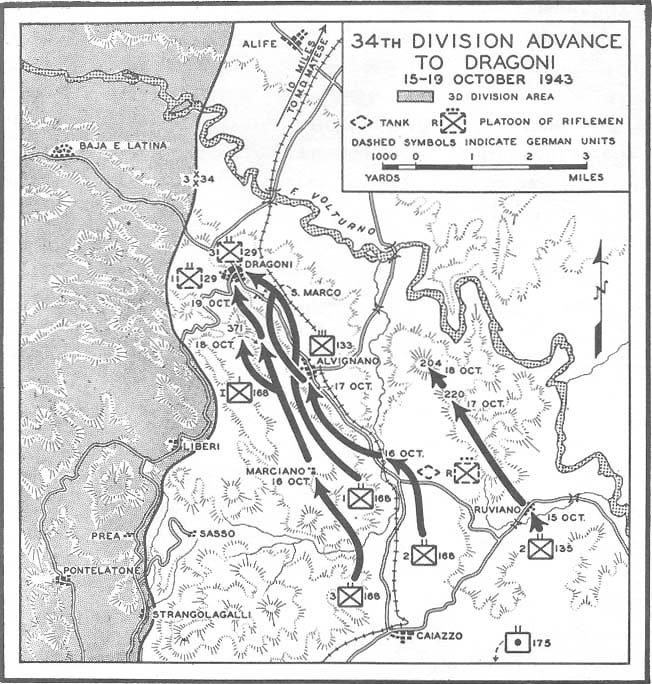
and the 2d Battalion captured Ruviano on the morning of 15 October. Throughout the day our troops met stiff resistance in the rolling grain fields, vineyards, and olive groves north of the village. During the night the enemy withdrew, and the regiment swept on up the valley for the next two days. By morning, 18 October, it had reached a line from Hill 204 east of Alvignano to the Volturno. The tired infantrymen were more than halfway to their first objective. Some two miles ahead of them, at the base of the hill mass on their left, was Dragoni; to their right across the valley were the forbidding Matese Mountains.
Before daylight on 116 October, the 168th Infantry, on the left of the 135th, had moved past the stone farmhouses in the valley and along the brush-covered ridges to seize Alvignano. The 3d Battalion met some resistance at Marciano, a hamlet high on the slopes above the
66
road, but drove the enemy off. Late in the afternoon the 2d Battalion beat back a platoon of German riflemen supported by a tank, but both battalions were on the dominating hillsides south of Alvignano, shortly after dark. On the morning of the 17th, after patrols had reported the town clear of the enemy, the 2d Battalion moved up and occupied Alvignano. Orders were then received to outpost the area until the 133d Infantry should be brought from reserve and sent up on 19 October to capture Dragoni.
On the morning of 18 October, General Ryder ordered the 168th Infantry to drive on toward Dragoni, and the 133d Infantry, commanded by Col. Ray C. Fountain, to cross the valley to seize the highway-railway bridge over the Volturno north of the town. The 135th Infantry would clear the valley and use one battalion that night to force a bridgehead across the Volturno. These movements, if successful, would cut off the German escape in the vicinity of Dragoni.
Elements of the 2d Battalion, 168th Infantry, started forward at 1100 toward Dragoni, followed by the 1st Battalion. Company I was sent along the ridge west of Alvignano, to pass above Hill 371, which had been reported in the hands of the 7th Infantry, and flank Dragoni from the left. While the 133d Infantry was pushing through
NORTH OF CAIAZZO the road from Highway 87 to Dragoni, route of the 34th's advance, runs through this valley. A German prisoner of war reported that on 11 October the men of his company were told they would move to Caiazzo if the Americans should cross the Volturno. At Caiazzo they would try to make a stand and, if necessary, fight their way back along this highway to the rear, even if the unit were encircled.
67
the vineyards and farms of the valley to take the bridges across the Volturno on the road to Alife, the patrols of the 3d Division were trying to block the road northwest of Baja e Latina.
The 2d Battalion, 168th Infantry, moved on up the valley abreast of Company I toward San Marco on the road to Dragoni. Rifle, machine-gun, and artillery fire was encountered a few hundred yards southwest of San Marco, and the 1st Battalion was sent around to the right to outflank the village. At 1530 the Germans laid a smoke screen across the front of both battalions and intensified their machinegun, mortar, and artillery fire. The enemy appeared to be getting ready for one of his typical late-afternoon counterattacks. In Alvignano elements of the 2d Battalion were released to move up and help repel the expected counterattack. When a second smoke screen was laid a few minutes after the first, elements of the 3d Battalion were alerted. Col. Butler and Lt. Col. Joseph E. Kelley, commander of the 175th Field Artillery Battalion, were in direct observation from the hills above Alvignano and placed accurate artillery concentrations on enemy self-propelled guns seen firing on our troops.
The Germans, elements of the 1st and 3d Battalions, 29th Panzer Grenadier Regiment, fired a green flare, the signal for an attack. The 168th Infantry intensified its rifle and machine-gun fire and continued firing from the artillery positions. The enemy troops, who had been ordered to hold positions in the area for a counterattack during the afternoon, could not face our fire. A white flare, the signal for a withdrawal, was soon observed, and the enemy attack was over. After our artillery forced back the three supporting self-propelled guns, the enemy withdrew toward Dragoni. In the meantime, Company I had worked its way through scrub oaks to Hill 371, which was found to be held by the Germans. With the aid of an artillery concentration, the company reached the crest at 1800, only a mile from the road junction southeast of Dragoni. The 2d Battalion moved on past San Marco, but the 1st Battalion in the valley on the right was pinned down until after dark.
Late in the afternoon of 18 October, the commanders of the 3d and 34th Divisions, which were converging on Dragoni, agreed to combine their efforts to take the town and seize the bridges beyond. The 3d Division asked General Ryder's permission to fire on the town and
68
INFANTRYMEN MARCH THROUGH DRAGONI. Early on 19 October a message came from a 3d Division observation post, "Heavy fog along west side of river.... Can't see Dragoni but heard bells ringing." At almost the same time elements of the 168th Infantry reported that they had entered the town without opposition.
was told: "It is your sector. Go ahead and knock hell out of it." General Truscott and General Ryder then reached the agreement that the 3d Division would keep the town interdicted during the night. The 34th Division would try to take it the following morning. The 168th Infantry advanced on Dragoni before daylight on the misty morning of 19 October and occupied it without opposition. The enemy had made his escape from a precarious position and was preparing for another delaying action farther up the valley.
Second Volturno Crossing of the 34th Division
On 18 October while the 133d Infantry was getting ready to pass through the 168th Infantry at Alvignano and drive on Dragoni, Col. Fountain returned from the divisional command post at noon with orders to advance immediately into the sector of the 45th Division and establish a bridgehead across the Volturno just north of the highway-
69
THE HIGHWAY BRIDGE ACROSS THE VOLTURNO on the road from Dragoni to Alife was blown by the Germans just before the 34th Division reached it. By 21 October trucks were crossing over the ponton bridge, seen in the center.
railway bridge on the road to Piedimonte d'Alife (Map No. 21, Opposite page). The 1st Battalion was to cross the river, sweep around to the right, and seize the bridge from the northeast, while the 100th1 and 3d Battalions drove on it from the southeast. Battalion commanders were cautioned to be on the alert for tanks and to take the bridge intact. General Ryder had directed that the regiment move with all possible speed in order to sever the enemy's route of escape from Dragoni and prevent the demolition of the bridge.
The battalions moved out through the vineyards and grain fields of the flat valley. The orchards, the high stumps supporting the grapevines, and the trees along the small streams provided some concealment but also denied our troops observation. The 1st Battalion reported at 1600 on the 18th that it had taken the wrong route to the river but that it was pushing on to establish the bridgehead. The battalion forded the waist-deep Volturno late that afternoon under
1. The 100th Infantry Battalion was activated on 12 June 1942 as a separate unit whose members were all to be native American citizens of Japanese ancestry. The battalion was initially composed of men from the Hawaiian Provisional Infantry Battalion. Men of the 100th Infantry trained in the United States and reached North Africa on 2 September 1943. On 29 September the battalion was attached to the Fifth Army.
70
intense but inaccurate artillery fire and reached its goal about midnight. The enemy had observed or anticipated the action and withdrawn his main elements. The 3d Battalion reached the railway-bridge site after midnight, and the 100th Battalion came up at dawn. The German demolition experts had been thorough, for only the stone abutments and one arch of the bridge remained.
Leading elements of Company I, 135th Infantry, began their crossing of the Volturno at 0230 on the morning of 19 October. They met no opposition as they slipped down the low banks and waded through the icy water to the plain on the other side. The remainder of the 3d Battalion crossed after daylight and took up positions on the road to Alife. During the day, patrols went into the old walled town and
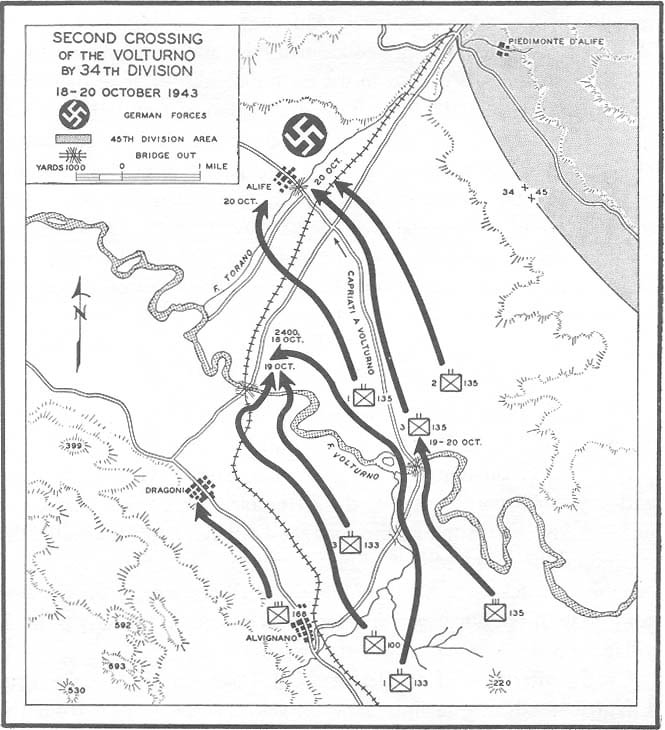
71
found it full of mines and booby traps. The bridge across the swift mountain stream was demolished. The streets were filled with rubble, for the town had been hit with good results by B-25's of the Tactical Bomber Force on the night of 12/13 October. The 3d Battalion, 133d Infantry, and the 100th Battalion forded the river after dark and closed in on the flats south of Alife, with the enemy in the olive groves on the high ground overlooking them. The 135th Infantry completed its crossing at 0155 on the foggy morning of 20 October.
As soon as the 135th Infantry was across the river, it advanced toward Alife. The infantry was delayed during the morning as it crossed the valley, which is cut by deep and swift canals. Demolition of bridges slowed the progress of the 776th Tank Destroyer Battalion, which moved along the poplar-lined road to support the attack. The 3d Battalion, hampered only by sporadic artillery fire and occasional minefields, entered bomb-blasted Alife before daylight on the 20th. When the fog lifted unexpectedly during the middle of the morning, the 1st Battalion was caught in the open flats southwest of the town. The enemy, in the hills above, immediately poured rifle and machinegun fire on the men and kept them pinned down. Until dark the battalion received considerable artillery fire and also encountered for the first time the German rocket gun, the Nebelwerfer. Meanwhile, the 45th Division occupied Piedimonte d'Alife to the northeast and on 20 October was placed in corps reserve. The right flank was secure, and the 34th Division was ready to take the place of the 45th and begin its drive up the valley toward Capriati a Volturno.
Toward Sant' Angelo d'Alife
The main effort of the 34th Division up the northeast side of the Volturno was begun by the 133d Infantry (Map No. 22, opposite page). The road that it was to use runs from Alvignano to Alife and then turns northwest over the fertile farm land below the towns of Sant'Angelo d'Alife, Raviscanina, and Ailano, nestling against the steep foothills of the Matese mountain range. This valley road runs roughly parallel to the Volturno, on the northeast side of the river, to connect with Highway 85. Smaller roads branch off laterally to reach villages on the lower slopes of the mountain mass.
On the afternoon Of 20 October, Col. Fountain ordered the 133d Infantry to advance against Sant' Angelo d'Alife at 1800 from the
72
vicinity of the blown bridge. The 100th Battalion was directed to seize the upper road junction, while the 1st Battalion followed to take the lower junction. Col. Fountain warned his battalion commanders that they could expect strong opposition that night and instructed them not to let their men be caught out in the flat, open terrain after daylight. The artillery opened up before 1800, and the sound of shells exploding in enemy positions crashed and echoed up and down the valley as the leading battalions started their advance.
The 100th Battalion made excellent progress in the early part of the evening of 20 October but was caught by crossfire of enemy machine
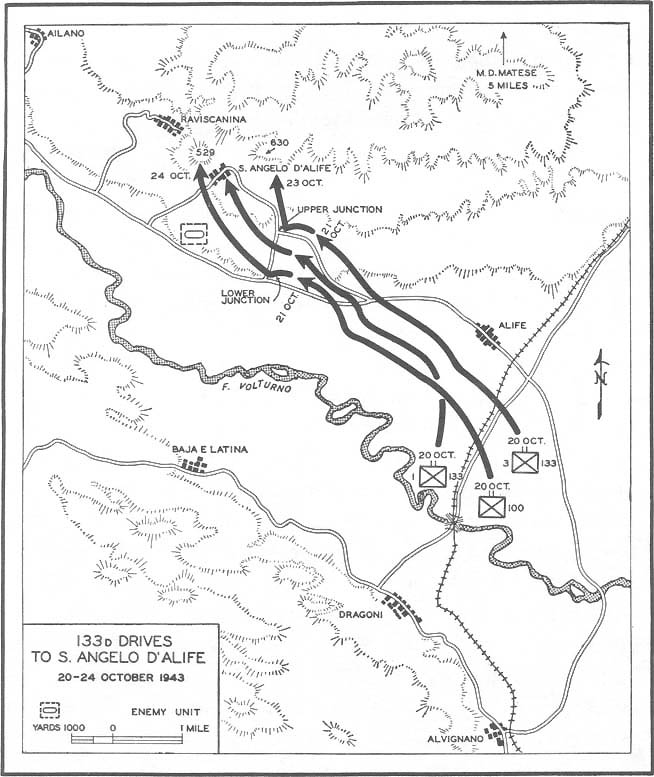
73
guns about midnight. The enemy positions on the slopes were extremely difficult to locate and mortar fire directed on them was ineffective. The 100th Battalion became disorganized, and the 1st Battalion was ordered to move to the right and advance along the lower road. The 3d Battalion, which had followed the 1st, was then committed to drive along the upper road toward Sant' Angelo d'Alife. Rifle, machine-gun, multi-barreled-mortar, and artillery fire was heavy throughout the night, but the advance continued.
The Germans in this sector were engaging in one of their determined delaying actions and were throwing everything they had at our troops. To support the advance, the 125th and 151st Field Artillery Battalions, which had crossed the river during the night, opened up at 1041 on 21 October and in the next twenty minutes expended 1,134 rounds. They fired until their ammunition ran low, but the infantry was still unable to make any progress. The battalions had become disorganized and the men were scattered over the valley.
Stubborn enemy resistance continued from the olive groves on the slopes. Early on the afternoon of 21 October, fourteen enemy tanks were sighted among the willows in the direction of the river. The infantry dug in and the divisional artillery fired periodic concentrations during the next four hours as first one observation post and then another spotted the tanks. The 125th Field Artillery Battalion, using a Cub plane for observation, caught six tanks in its fire and threw 736 shells at them during the afternoon. The battalion was able to report one tank destroyed and four immobilized; the remaining tanks withdrew only after inflicting heavy casualties on the 133d Infantry. After dark the 100th and 3d Battalions got up on the slopes southeast of Hill 630, but the 1st Battalion was still out in the open valley.
During the night of 21/22 October the enemy made no counterattacks against the 133d Infantry, which continued its advance on the foggy morning of 22 October. The 100th Battalion reached the lower road junction, and the 3d Battalion was soon astride the upper one without opposition. During the night the Germans had withdrawn. The battalions then outposted their position and prepared to take Sant' Angelo d'Alife and Hill 529 the next morning. Through the morning of 23 October the attack continued. While the 3d Battalion climbed over the terraced slopes of Hill 630, the 100th Battalion at-
74
tempted to outflank the village by driving across the lower ground to the south. The 3d Battalion passed above the village during the morning, but the 100th Battalion was pinned down by machine-gun fire, and tanks were observed on its left. During the afternoon tanks were again in the valley and inflicted heavy casualties on the 100th Battalion before they were finally driven off. Rearguard enemy units held on stubbornly throughout the day and periodically laid down intense mortar and artillery fire. Enemy machine gunners occupied well-selected positions in the olive groves and behind stone walls to delay the progress of our infantry.
The 1st Battalion moved up through the mist on the morning of 24 October and entered the walled and narrow streets of Sant' Angelo d'Alife without resistance. The 100th Battalion then advanced through mined and booby-trapped areas and occupied Hill 529, the cone-shaped bare top of which is crowned with the crumbling walls of an ancient castle. The enemy had withdrawn beyond Raviscanina, a village in a draw on the other side of the hill. The battalions had advanced some seven miles up the valley, after making their second crossing. Sant' Angelo d'Alife and its commanding heights were secure, but the four days and nights of fighting had cost the 133d Infantry 59 men killed and 148 wounded.
The Battle for Hill 235
The next objective of the 34th Division was the high ground around Ailano, and Mount Cavuto (Map No. 23, page 76). West of the Volturno the 3d Division was preparing to drive across the valley and over the mountains toward the Mignano Gap. During the afternoon Of 25 October, the 1135th Infantry moved up to Sant' Angelo d'Alife to pass through the 133d Infantry and take up the chase. The 3d Battalion of the 135th was to climb the steep slopes of the hills, flank Ailano to the north, and cut the road from Ailano to Valle Agricola. The 2d Battalion was to drive up the valley over more broken terrain and flank Ailano to the south.
The 3d Battalion, 135th Infantry, moved up during the night of 25/26 October and advanced before dawn over the hills above Raviscanina. At 0530 divisional artillery began firing successive concentrations that progressed at the rate of one hundred yards every six
75
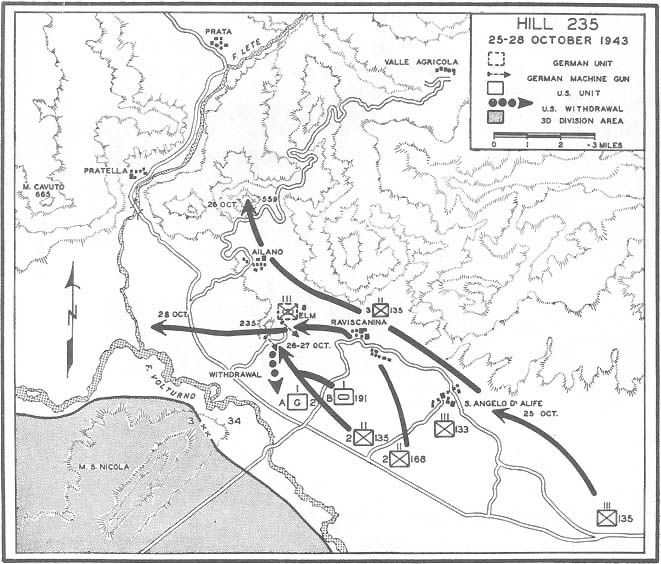
minutes. The 185th Field Artillery Battalion alone expended 828 rounds in the next two hours. Meanwhile, men supplied by the 100th Battalion to guide the 2d Battalion, 135th Infantry, to its line of departure became lost in the darkness and fog of the early morning, and at 0530 the battalion was several hundred yards to the rear of the line. When the 2d Battalion finally jumped off at 0605, it left positions several hundred yards too far north.
The 3d Battalion climbed slowly over the wooded mountainsides above Raviscanina and Ailano. Enemy opposition was slight, and the battalion crossed the road between Ailano and Valle Agricola during the afternoon and occupied Hill 559. As soon as the fog lifted, the 2d Battalion was pinned down by rifle and machine-gun fire from Hill 235, rising less than twenty-five meters above the broken valley. This rolling hill, several acres in size and covered with brush and small evergreens, commands the area from the foothills to the river. A deep ravine runs along the east side of Hill 235; toward the west the terrain is broken and rough.
Unsuccessful efforts were made during the morning to maneuver
76
men over the open ground around both flanks of the 2d Battalion. Company A, 2d Chemical Battalion, battered the hill with high explosive shells, but the infantry could make no headway against enemy fire from well-hidden positions. Meanwhile, Generals Clark, Lucas, and Ryder visited the regimental observation post on Hill 529, and General Ryder attached Company B, 191st Tank Battalion, to the 2d Battalion for a continuation of the attack the next morning, 27 October. During the afternoon an observer sighted troops south and southeast of Hill 235. His message specified an area previously reported held by the 2d Battalion, and the troops were assumed to be ours.
The 2d Battalion, preceded by tanks, was to resume the attack at 0530, but the tanks were held up by the difficult terrain, and the attack was delayed. An observer saw troops moving west over the hill and immediately reported that it had been taken. The battalion soon discovered that these were Germans who had been south and southeast of the hill the day before. The tanks arrived and tried to move to the right to attack the north nose of Hill 235, but one hit a mine, one turned over, and one was knocked out by artillery. On the hill
HILL 235, two knobs joined by a shallow saddle, provided the Germans with defilade for tanks and concealment for infantrymen. The larger of the two knobs is shown. The Alife-Pratella highway is about one thousand yards to the left (west); a narrow ravine some twelve feet deep runs across the base of the hill to the right. Shell fragments from American artillery literally cover the ground.
77
the enemy had machine-gun positions well hidden in the brush and was using from seven to ten tanks in hull-down positions as artillery. The 2d Battalion organized for another effort after noon, but twelve enemy tanks came up on the left flank and prevented the attack.
By nightfall on 27 October, elements of the 8th Panzer Grenadier Regiment on Hill 235 had shown the strength and stubbornness of their resistance. General Ryder ordered the 168th Infantry, which was in reserve, to pass through the 135th Infantry and renew the attack next morning. A heavy artillery concentration started at 0930; at the same time twenty-four A-36's bombed Pratella and the bridge to the south over the Lete River. The 2d Battalion, 168th Infantry, assaulted Hill 235 at 1000. The Germans had withdrawn during the night. From this small hill in the center of a valley twelve hundred yards wide, flanked by the mountain and the river, the enemy had for two days successfully held up the advance of the 34th Division. Another typical enemy delaying action was over, and our troops plunged on west to the Lete River.
After the enemy retreated from Hill 235, the 34th Division advanced north beyond the junction of the Lete and Volturno rivers. During 29 October the 135th Infantry drove up the road and occupied Pratella and Prata along the river, finding that Hill 325 in the narrow valley
PRATELLA, WITH HILL 325 on the right, is typical of many small hill towns near the head of the Volturno River. On 30 October the enemy harassed the 34th Division from 0830 to 1600, concentrating his fire on the road running through Pratella. Reports indicated that at least twenty-five pieces were firing from seven different locations in this area.
78
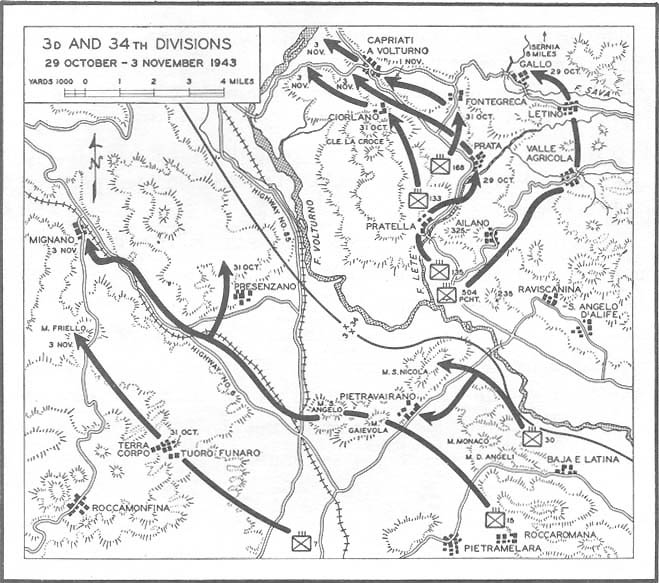
by Pratella was fortunately not held by enemy rearguard troops. On 31 October the 133d and 168th Infantry continued up the Lete Valley and then into the valley of the little Sava River (Map No. 24, above). To protect the division left flank, the 133d Infantry climbed over the steep, brush-covered mountains on the left and occupied Ciorlano, a village clinging to the terraced slopes of La Croce Hill. The 168th Infantry took Fontegreca and drove on to Capriati a Volturno on 1 November. During the next two days the 34th Division drove the remaining enemy forces northwest toward Highway 85. To continue the pursuit the division would have to make a third crossing of the Volturno River.
Advance Toward the Barbara Line
While the 34th Division was struggling forward along the northeast side of the Volturno, the 3d Division was driving the enemy from the mountains and valleys on the other side (Map No. 24 above). The division was aided by Allied fighter-bombers which struck heavily
79
at gun positions in its line of advance. The 30th Infantry cleared Mount degli Angeli and Mount Monaco, drove on to Mount San Nicola, and occupied Pietravairano. Here the men saw the effect of Allied bombings on 19 and 26 October, especially on the roads and bridges near the village. The 15th Infantry crossed the valley from Roccaromana and swept the enemy from the rocky slopes of Mount Gaievola and Mount Sant' Angelo. The division then prepared to push on toward the Mignano Gap.
On 31 October the troops attacked across the valley to cut the Roccamonfina-Mignano road and to take Mount Friello. The 7th Infantry drove through Tuoro Funaro and Terra Corpo without gaining contact with the enemy, while the 15th Infantry advanced up Highway 6 and sent a battalion along the slopes above Presenzano. During 3 November the 7th Infantry occupied wooded Mount Friello, where the Germans had left numerous mines and booby traps. At the same time the 15th Infantry closed in on Mignano. General Truscott's 3d
INFANTRYMEN OF THE 3D DIVISION advance in the scrub-covered hills near Pictravairano. Instructions to the men assigned to capture the high ground above the town were to "dig in, group well, and play bell with any infiltration."
80
Division had secured the left flank of VI Corps and was in contact with the British 10 Corps.
To guard the army's right flank, the 504th Parachute Infantry, 82d Airborne Infantry Division, under the command of Col. Reuben H. Tucker III, came up the Volturno Valley, turned northeast through the mountains from Ailano to Valle Agricola, and advanced through Letino and Gallo. The 45th Division, which had been in reserve, prepared to pass around the left flank of the 34th Division and cross the river south of Venafro.
Along the 10 Corps front the British had overcome their initial handicap, when strong enemy attacks had forced them back west of the Triflisco Gap, and by 17 October were able to move tanks of the 7 Armoured Division across the river at Grazzanise (Map No. 30, inside back cover). By 19 October, the 56 Division had patrols on the Calvi Risorta Hills, overlooking Highway 6. The strain on the temporary bridging limited the development of a swift thrust anywhere in the 10 Corps zone, however, and it was a week before the 56 Division was in complete command of the hills. Meanwhile, the 7 Armoured Division prepared to exchange sectors with the 46 Division and to drive on the left flank of the corps to Mondragone. By 31 October elements of the 56 Division had captured Teano; the 46 had advanced to the town of Santa Croce, and the 7 Armoured occupied Mondragone. In two more days, 10 Corps reached the Massico ridges and pushed a short distance farther into the Mount Santa Croce hill mass. The Barbara Line was already under attack.
Between the Volturno and the Barbara Line the enemy had planned his actions to gain the greatest amount of time with the least expenditure of force. Outnumbered by the Allies and facing superior air and fire power, the Germans had to depend on their skill in using the advantages of the terrain. The nature of the operation, a planned withdrawal, enabled them to make a careful study of the areas which they expected the British and Americans to occupy. In defiladed or densely wooded ground, their effective shelling showed that they had precise registrations on likely approaches, gun positions, and troop locations, and could fire on these targets without direct observation. Wherever the Fifth Army might move or bivouac, the enemy placed mines and booby traps, across roads and railways, blocking the way around demolitions, in streams and river banks, and in towns
81
AUTUMN IN ITALY is by far the wettest season of the year. October and November rainfall in the country through which the VI Corps was fighting will usually exceed four inches in each month. The picture above shows wire being laid through the rain-flooded country in the vicinity of Pietravairano. In the one below a jeep is trying to get through the mud.
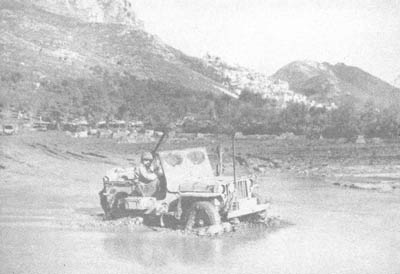
82
and villages. Anti-personnel mines lay concealed along hedges and walls, and booby traps were set in haystacks, ravines, and olive groves, and on hillsides and terraces.
To counteract the limitation in strength caused by commitments to other fronts and by previous losses, the Germans had primarily used small, mobile infantry units for these rearguard actions, reinforcing them with heavy weapons. Self-propelled guns, which could be hidden against walls or among trees and quickly moved back after covering the infantry's withdrawal, were effective and economical weapons. Along the coast in the British zone, where the open plain offered few natural defensive positions, the enemy had concentrated his strength in the towns. Inland, his troops had held on to the heights above the villages, from which they could command Allied approaches and cover their own escape. If they were driven from these heights, they counterattacked only when there was a chance of imposing further delay; otherwise they withdrew to selected positions, waiting always until darkness hid their movements from Allied air patrols.
Against these tactics the Fifth Army had, in twenty days of fighting, secured its bridgehead along the entire length of the lower Volturno River and had advanced fifteen to twenty miles along a forty-mile front. Despite the bad weather, Allied fighter-bombers had struck the enemy again and again in the area at the head of the valley. The Fifth Army had not engaged the main enemy forces, but the fact that its advance elements had overrun several enemy gun positions indicated that the Germans were withdrawing faster than they had intended.
83
page created 17 September 2001